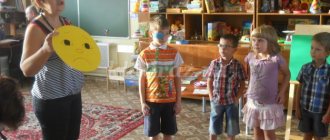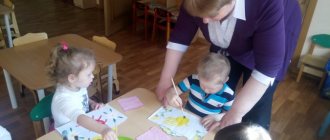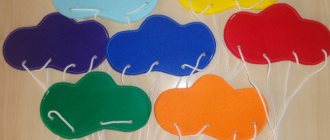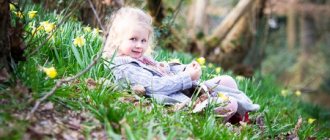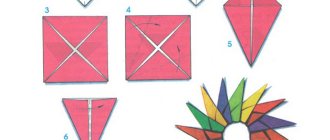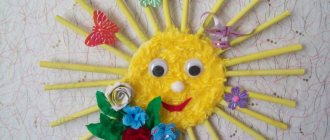Entertainment for young children. Scenario
Game - activity “Sunshine and Rain” for children from 1-2 years old using ICT
Author: Gergert L.V., MBDOU No. 22 “Orlyonok”, Karpinsk, Sverdlovsk region. Tasks. Practice the ability to distinguish between sizes: large, small. distinguish colors: blue, yellow; quantity: a lot, a little. Enrichment of vocabulary: cloud, droplets. Development of visual perception. Development of auditory perception. Develop attention, memory, thinking. Development of fine motor skills of the hands. Cultivate a friendly attitude towards peers. Equipment. Picture of the sun, clouds; droplets and a cloud for breathing exercises, a bucket, raindrops from napkins. Tray with semolina, laptop, presentation “Sunshine and Rain”. Handout. Pictures of the sun and rays for each child, clouds and droplets for each child. Children are included in the group. Educator. Look, the sun has come out. I bring the children to the wall on which there is a picture of the sun. Greeting “The sun rose in the morning” In a golden cradle The sun slept across the river. (Place palms under cheeks) The sun rose in the morning and woke up the children. (Raise your hands smoothly) The children went out for a walk, (Clapping their hands on their legs one by one) They began to jump and gallop. Didactic game “Rays for the Sun”.
The teacher shows yellow circles: large and small. Now you can make a beautiful sun yourself. The yellow circle is the sun, and place the rays around the sun. Like this. (Teacher shows). Independent activity of children. I specify the color and size of the rays and circles. The sun is shining, the kids are all walking. Breathing exercises “The wind blows, the rain drips.” Children blow on raindrops. A strong wind blew, a weak wind blew. Educator. (drops droplets from wads of napkins onto the floor) Look how many droplets fell from the cloud? Lots of drops. Let's collect them and put them in a bucket. Children collect droplets in a bucket. Didactic game "Rain".
Educator.
Guys, the wind blew, clouds appeared in the sky and it began to rain. Here we have clouds: big and small. Large droplets drip from a large cloud, small droplets from a small one. Place the droplets near the clouds. I’m checking the size and color of the clouds. I cover the sun with a cloud. Educator. Guys, now let's talk about the sun and the rain. Screening of the presentation “Sunshine and Rain”.
Presentation “Sun and Rain”
Finger painting on semolina “The rain was dripping.” When drops fall from a cloud to the ground, they leave traces. Let's draw the trails of the droplets. Place your finger, press and remove. Here one drop fell. And a lot of droplets fall from the cloud, so we’ll do this with our finger many times. You will get a lot of drop marks. How many drops fell from the cloud? Lots of drops. I'm removing the cloud. The sun is peeking out. P/I “The sun is rising.” This is how the sun rises. Higher, higher, higher. (Raise your hands up, stretch) By night the sun will set Lower, lower, lower. (Sit down slowly, lower your hands to the floor) Okay, okay. The sun laughs. And we all have fun under the sun. (Clap your hands) Well done!
We recommend watching:
Scenario of sports leisure for children of the 2nd junior group “Winter fun for kids” Synopsis of a game lesson in an early age group Synopsis of a lesson on sensory education of the 1st junior group Synopsis of educational activities with presentation for the 1st junior group
Similar articles:
Folklore entertainment for children of primary preschool age in kindergarten. Scenario
Gaming leisure time in 1st junior group
Lesson summary for an early age group. Vegetables: turnips and carrots
Lesson summary for an early age group. Vegetables: beets and potatoes
Summary of a lesson in an early age group on a winter theme. Hare and fox
Progress of the lesson:
Greeting "The sun has risen in the morning"
The sun slept in a golden cradle across the river. (Parents sit the babies on their laps, the babies’ arms are folded in front of the chest, forming a circle “cradle”. Imitation of rocking a baby in their arms).
The sun rose in the morning and woke up the children. The children went out for a walk and began jumping and jumping. (Hands smoothly rise, separate, smoothly fall. Clap your palms on the legs alternately, pat at the same time).
And... (child's name) is here. (We point with open palms at the named children).
Listening to an excerpt from E. Grieg’s musical work “Morning”
Let's call the sun. Repeat after me:
Sunny, show yourself soon! Warm us up guys!
To the sound of music, the teacher lifts the sun by a thread.
Reading the poem by Agnia Barto “The sun is looking through the window”
The sun looks out the window. It warms our room. We clapped our hands. We are very happy about the sun.
Didactic exercise “This is how the sun rises”
This is a circle. Yellow color. This will be our sunshine. Take the yellow circle in your hands.
This is how the sun rises. Higher, higher, higher. (Raise your hand with the sun up, stretch)
By night the sun will set Lower, lower, lower. (Slowly squat down, lower your hand to the floor)
Good good. The sun laughs. And we live happily under the sun. (Clap)
Didactic exercise “A cloud covered the sun”
Suddenly the wind blew. Like this. Blow as the wind blows. The wind brought a cloud. Here she is. The cloud covered the sun. Place a cloud on top so that it covers the sun. The wind blew again. Blow. And the cloud flew away. The sun opened and shone.
Construction of “Radiant Sun”
Now you can make a beautiful sun yourself. The yellow circle is the sun, and we will make the rays from sticks. You need to lay them out around the yellow circle. Like this. (Teacher shows).
Outdoor game “Rain and Sun”
The sun is shining brightly and all the kids are walking. (The teacher holds the sun on a stick, the children walk on the carpet) But the sun hid behind a cloud, and it began to rain. All of you run under my umbrella. (The teacher opens the umbrella, the children run to him).
Finger gymnastics “Raindrops”
Raindrops fell on the blades of grass. Drip-drip droplets, Drip-drip small. (Open one palm, tap it with the fingertips of the other hand, imitating raindrops)
Children catch these drops on their palms. Drip-drip droplets, Drip-drip small. (We do the same with the other palm)
Exercise “Collect droplets”
That's how many droplets fell from the cloud. Lots of drops. Let's collect them and put them in this basin.
Finger painting on cereals “It was dripping rain”
When drops fall from a cloud to the ground, they leave traces. Let's draw the trails of the droplets. Place your finger, press and remove. One drop fell. And their clouds have a lot of droplets falling, so let’s do this with our finger many times. You will get a lot of drop marks. How many drops fell from the cloud? Lots of drops.
Musical-rhythmic exercise “Rain-rain, ley-lay-lay”
Children beat out the rhythm on the drums with sticks.
Reading the nursery rhyme “Rain”
Children, let's ask the rain to stop pouring drops on us. The teacher reads a nursery rhyme, and the children shake their index finger.
It's raining, it's raining, it's pouring down, getting the little kids wet!
Outdoor game “Jump over the puddle”
These are the puddles left after the rain. Try jumping over a puddle. And this puddle is very big, we can’t jump over it. Therefore, let's throw a bridge over it and walk along it.
Didactic game “Don’t get wet”
Here are my rain showers (a stick with transparent bags cut into ribbons attached to it). The teacher tries to touch with “rain” those parts of the children’s bodies in question, and the children hide them.
Rain, rain, have fun! Drip, drip, don't be sorry! Be quiet, don't knock - Don't get our hands wet! Keep it low, don't knock - Don't get our ears wet! Lay low, don't knock - Don't get our cheeks wet! Be quiet, don't knock - Don't wet our eyebrows! Lay low, don't knock - Don't get our shoulders wet!
Bas-relief sculpture “Sun”
Children stick a yellow plasticine ball onto cardboard cut out in the shape of a cloud, press down and stretch out the rays with their fingers.
Summary of GCD in the 2nd junior group on the topic: Sunny
Abstract of the GCD in the 2nd junior group on the topic “Visiting the Sun.”
Description of the material: I offer you a summary of direct educational activities for children (3-4 years old) on the topic “Visiting the Sun.”
This material will be useful to teachers of the younger group. This is a summary of an educational lesson aimed at cultivating interest in the sun and developing curiosity in younger preschoolers. Procedure:
1. GCD slide “Visiting the Sun”
Children enter the group and greet the guests.
They stand in a semicircle. An audio recording of the Turtle and Lion Cub's song about the sun is played. Educator : Introductory and organizational stage. "Good morning!" Psychological attitude towards activity, creating an atmosphere of interest. -Good morning, eyes! You woke up? (children, together with the teacher, stroke the eyelids) - Good morning, ears! You woke up? (stroke ears) -Good morning, hands! You woke up? (clap our hands) - Good morning, legs! You woke up? (stomping) - Good morning sun! We woke up! (hands open towards the sun). Let's all smile and share the good mood with each other and with our guests. Say hello to them. Educator: Children, now I’ll tell you a riddle, and you guess it. The golden apple rolls across the sky and the rays in a smile are very hot. Children's answers. (sun) Educator : That's right, and today we will talk about the sun. How can you call the sun affectionately? Children's answers. Educator: That's right, honey. Educator: Look, children, what kind of sun came to visit us today. 2. Slide sun
What is it like?
Children's answers (cheerful, joyful, warm, hot, radiant, kind, clear, bright, beautiful, gentle, affectionate, red-sun). Educator : Now let's talk about the sun in poetry. The sun looks out the window, looks into our room. We clapped our hands, We were very happy about the sun. A. Barto The sun examined the earth, Each ray left a trace. There is no more important thing in the world than giving warmth and light. V. Nesterenko A cloud is hiding behind the forest, The sun is watching from the sky. And so pure, kind, radiant. If we could get him, we would kiss him. 3.Slide the sun is smiling
Let's blow a kiss to the sun, guys.
4. slide the sun hid behind a cloud
Educator: Now let's play.
The game is called "Sunshine and Rain". I suggest we stand in a circle around our sun. Now magical music will play and we will turn into rays of sunshine. If our sun laughs, we will jump and run merrily, but as soon as you hear the sound of rain - like this (the sound of a metallophone), you must hide under an umbrella. 5. Slide people, animals, birds, plants Educator: Without the sun it’s hard for everyone, people, animals, birds, and plants. And when the sun is shining everyone is happy! What happens if the sun disappears? Children's answers (it will become dark, cold, plants will not grow). Educator: That's right, and if plants don't grow, then animals, birds and people will have nothing to eat. But our sun shines on us and we are happy about it, and plants grow. The teacher draws attention to the container in which dummies of vegetables and fruits are hidden in the sand. Educator: Children, look what I found. What's inside? Let's check. Place your hand in the container (children take turns putting their hand down and taking out dummies of vegetables and fruits). D/game “Find out by touch” (children take out vegetables and fruits, name them, color and shape) 6. Slide vegetables and fruits 7. Slide sky (music, the sun came out) Educator: Children, look, there is a sheet of blue paper on the table It’s like a piece of the sky, but there’s no sun on it. Let's make suns and send them to this sky. To do this, take yellow dough, first roll it into a ball, then flatten it, make a circle, and then stick yellow-colored sticks (rays) into the side. And let's send our suns to the sky and admire them. Place on cardboard. 8. Slide the sun in the sky Educator: Your suns turned out beautiful. Result: What came to visit us today? (sunny) Who did you guess riddles about? Who did we read poems about? What happens if the sun disappears? Well done. Educator: Guys, you are also rays of sunshine. Warm your palms with your warmth (blow into your palms, rub them). Now convey your warmth and tenderness to our guests. Come, don't be shy! (children approach the guests and take their hands). Look how warm and happy everyone is! Let's go pass on our warmth to other children.
We recommend watching:
Summary of GCD for children of the 2nd junior group on the topic: Winter Summary of GCD cognition using ICT in the 2nd junior group. Journey to the autumn forest Notes of GCD in the 2nd junior group: Wild animals Notes of GCD on speech development in the second junior group topic: Vegetables
Similar articles:
Summary of lessons in kindergarten in the 2nd junior group. Group room
Summary of lessons in kindergarten in the 2nd junior group. My family
Summary of a lesson in the junior group of kindergarten on the topic: “Human nutrition”
Lesson notes about kindergarten. Junior group
Benefits for preschool children under the general title “Sad - Fun”
Didactic manual
for preschool children
"Sad - fun"
Explanatory note
The manuals under the general title “Sad and Happy” were created for children aged 5-7 years. They can be used in frontal classes, in working with a subgroup of children on musical development, solving problems in the “Didactic game” and “Listening to music” sections.
Target
: learn to model the character of music, develop modal perception of music
More expected results
: children will distinguish musical works, name some composers, and will be able to model the nature of musical works.
“Sun and cloud” (for magnetic board)
The manual was developed for children 5 years old (middle group). The manual consists of figured pictures (22X15) of the sun and clouds, symbolically denoting cheerful and sad music; magnets are glued to the back of the pictures. After listening to a piece of music, the child (of his own free will) comes to the table, selects a picture that matches the character of the music and attaches it to the magnetic board.
“The Sun and the Cloud” (on a stick)
The manual was developed for children 5-6 years old (middle, senior group). The manual consists of small figured pictures (6/7X6) of the sun and clouds, which are glued to two sides of a flat stick (toothbrush handle). The number of sticks should correspond to the number of children. After listening to a piece of music, children turn the image of the sun towards themselves if the music was cheerful, or a cloud if the music was sad.
"Determine the mood of the gnomes"
The manual was developed for children 6-7 years old (senior, preparatory group). The manual consists of figured pictures of gnomes with a calm expression on their faces, circles with sad and cheerful facial expressions. The number of pictures of gnomes can correspond to the number of children, and can be designed for a subgroup of 8-10 children. In accordance with the nature of the music, children put circles on the gnome's face, that is, they change his mood in accordance with the nature of the music. The game is not played at the table, so each child receives a cardboard tablet on which he places a gnome figurine.
“Sad and happy” (color cards)
The manual was developed for children 6-7 years old (senior, preparatory group). The manual consists of cards with colored circles: red, symbolically denoting happy music, and blue, symbolically denoting sad music. Children are given two cards. In accordance with the nature of the music, children show cards with a red or blue circle.
“Sad and happy” (cards with facial expressions)
The manual was developed for children 7 years old (preparatory group). The manual consists of cards with happy, sad and calm facial expressions. Children are given two cards. At the first stage of mastering the game, children are given cards only with sad and cheerful facial expressions, then with cheerful and calm ones. After 2-3 lessons, different cards are distributed, some children have happy and sad facial expressions, others have cheerful and calm facial expressions, others have sad and calm facial expressions. In accordance with the music they listened to, the children raise a card and show it to the music director. If the child does not have the appropriate card, then he does not show the card. For example, a music director plays a piece of a sad nature, but a child who has cards with cheerful and calm facial expressions does not show the cards, but waits for the piece to be of a cheerful or calm nature. It is recommended to hand out cards with different facial expressions to children each time.
